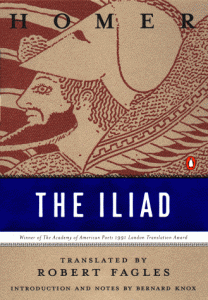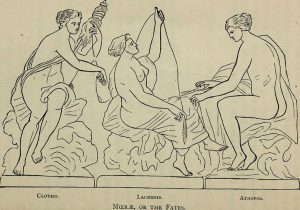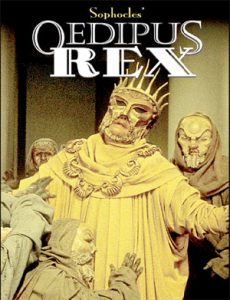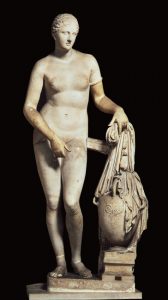 Athena, goddess of Wisdom and War, at the Louvre. Roman copy from the 1st century BC/AD after a Greek original of the 4th century BC, attributed to Cephisodotos or Euphranor.
Athena, goddess of Wisdom and War, at the Louvre. Roman copy from the 1st century BC/AD after a Greek original of the 4th century BC, attributed to Cephisodotos or Euphranor.
When I took this class of Gods and Heroes of Classical Mythology, we had discussed the importance of Athena throughout our semester. I knew the myth and legends of her and how she provided aid to heroes for their journey to achieve victoriously. I know she helped Hercules, Achilles, Hector, and Perseus as well as heroes from The Iliad and The Odyssey from both my high school literature classes and college classes. But I did learn a lot about Athena in deeper detail from this class and how she helped humans in a complex way within the mythology tales. My personal perspective about Athena changed because I can see her more as an important goddess to our modern world and how she shapes us and how she lives in each of us. When we went to London, we had seen Athena artifacts, artwork and sculptures everywhere on important historical landmarks and basic life. We started to learn more about her and how she herself was a personification of wisdom, peace, and prosperity to demonstrate each nation with balance. The Goddess Athena became an important mythological being since she had major effects on the development of human civilization and the development of different human perspective.
Dr. Tony mentioned to us that Athena was a very important goddess from ancient times and became an important being. She also signified the messages for women being powerful individuals and how she should be equal to the males she helps. She was a view to help rulers to achieve greatness in military matters and government from ancient times until now. She is one of the most important figures within women history to give them a boost to show the importance of how women are. Her Roman name is Minerva, which is a counter partner to Athena. She was the most active in the humans than another god from Mount Olympia. Athena is the most famous and beloved deity from ancient times and still in modern times. Her attributes are her shield, her helmet, her spear, her pet owl, and a gorgon’s head or Medusa’s Head on her chest. She is one of the three holy virgin goddesses, a being of wisdom, a being of hand-man crafts and a being of warfare strategist. She had helped many famous heroes, kings, and warriors in Ancient Greece and Rome. Zeus had many children with many women, and his personal favorite child was Athena herself. The birth of Athena was an interesting one; according to Mythencyclopdia.com, it discusses that Zeus had Metis pregnant and the oracle said to him that they will have a girl and if they had a son he will be overthrown. So Zeus ate Metis to prevent this from happening. One day Zeus had a headache and Hephaestus used his ax and split Zeus’s head and here come Athena fully dress in her armor and into womanhood (Advameg Inc, 2017).
In ancient times, Athena herself was able to influence the building of the city Athens and The Parthenon. The goddess mythology helps the development of human civilization and how it came into being. There was a famous myth of how Athens came into being, according to mythencyclopedia.com. It states that there was a contest between Poseidon and Athena in which whoever won came have the city. Poseidon used his trident and hit the ground and water came out. The people seemed happy at first, but they realized that it was salt water. Athena planted an olive tree and it won the people over. She became the patron of the city and named the city after her, calling it Athens (Anon, Myths Encyclopedia). Throughout Greece and Rome, she became the most used patron goddess of the ideal and was worshiped more than any other gods. The reason is that she was down to earth and understood the mortals better than the other gods. She wanted to help them achieve greatness and avoid endless war with each other nations, to work together to develop a harmony world. She was a benevolent being and punished the harshness to whom deserved the punishment with justice and law. The citizens put her images on coins, festivals, athletic games, armor and weapons, and she was a major protector of Sparta, Corinth and Thebes (Cartwright, 2012).
In modern times, Athena’s presences are still here with us. She was used in important symbolism throughout our world. People used her status as intelligence, logic, wisdom, reasoning, and creativity to help pursue a higher meaning of being human (The Goddess Path and The Goddess Gift). The Goddess Athena and her influences over time made an impact with herself in modern pop culture as well. Within the academic world, Minerva and Athena both symbolize intelligence and wisdom. The scholars used them as the symbol of the educational world to express themselves and used her as the logo to honor the Warrior Goddess (A Voyage with the Gods Athena). Another important aspect of Athena is that she is in a lot of classical art, literature, music, toys, sculptures, television shows, movies and much more. In the classical arts, she appears in her famous armor and wears her royal Helmet, symbolizing war and power to the females.
In the 90s, Athena was played by Paris Jefferson from the popular show called Xena: Warrior Princess. Athena does help us evoke us human into the higher consciousness of expressing the emotion and the imagination. This had increased the inspiration of a new generation of artist, writers, musicians, historians and video game developers. All the literature, history, arts and all resources I found so far do agree with the importance on how the arts and literature from Athena herself had a major influence on our evolution; she also had an influence on the advancement of modern fine arts and modern literature. The goddess’s mythical tales help the increase of the high level of great creative thinkers, artist, and writers alike. The Goddess Athena will continue to influences us and affect us with her tales and herself, and she will be with us on our journey into the bright future of humanity.
 Athena play by Paris Jefferson from Xena: Warrior Princess 1995-2001
Athena play by Paris Jefferson from Xena: Warrior Princess 1995-2001
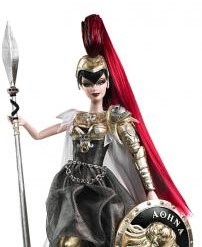 Barbie Version of Athena Designed by: Linda Kyaw Release Date: 2/18/2010 Product Code: R4492 Gold Label®
Barbie Version of Athena Designed by: Linda Kyaw Release Date: 2/18/2010 Product Code: R4492 Gold Label®
References:
Advameg, Inc (2017). Encyclopedia of Myths. Athena Available at http://www.mythencyclopedia.com/Ar-Be/Athena.html [Accessed June 29, 2017].
Cartwright, M. (2012). Ancient History Encyclopedia, Athena Definition Retrieved from http://www.ancient.eu/athena/
MediaWiki. New World Encyclopedia. (2016) Athena, Available at http://www.newworldencyclopedia.org/entry/Athena [Accessed June 30, 2017].
The Goddess Path and The Goddess Gift (2014). Athena, Greek Goddess Greek Goddess of Wisdom and Craftsmanship, Available at http://www.goddessgift.com/goddess-myths/greek_goddess_athena.htm [Accessed June 29, 2017].
A Voyage with the Gods Athena. (2011) Athena and Minerva in today’s world, Available at http://151.12.58.141/virtualexhibition/today.html [Accessed June 29, 2017].
IMDb.com, Inc.(2017) Paris Jefferson Actress, Available at http://www.imdb.com/name/nm0420219/ [Accessed June 30, 2017].
Images References:
Athena, goddess of Wisdom and War, at the Louvre. Roman copy from the 1st century BC/AD after a Greek original of the 4th century BC, attributed to Cephisodotos or Euphranor. https://simple.wikipedia.org/wiki/Athena
Athena play by Paris Jefferson from Xena: Warrior Princess 1995-2001 https://vignette2.wikia.nocookie.net/hercxena/images/3/38/S05E14_%E2%80%93_Athena.jpg/revision/latest?cb=20150126163520
Matte ‘s Barbie Pallas Athena Designed by: Linda Kyaw
Release Date: 2/18/2010 Product Code: R4492 Gold Label® http://151.12.58.141/virtualexhibition/today.html
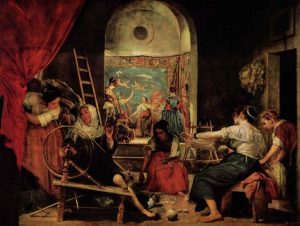

 is a good or a bad guy a little bit more complicated. Even though he wasn’t in his right mind, someone has to take the blame and I think that it still lands on his shoulders.
is a good or a bad guy a little bit more complicated. Even though he wasn’t in his right mind, someone has to take the blame and I think that it still lands on his shoulders. 